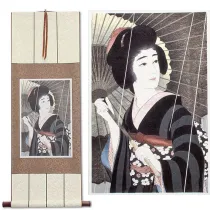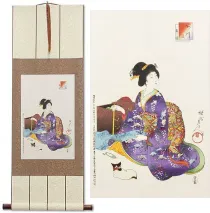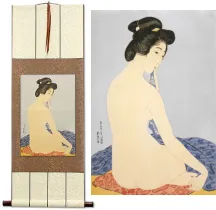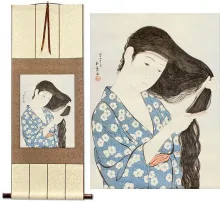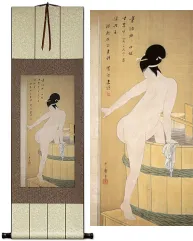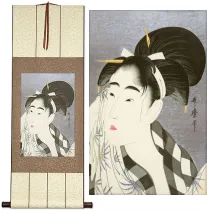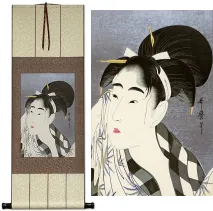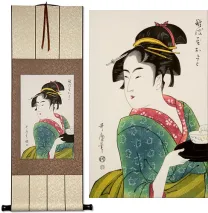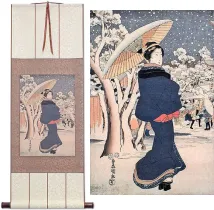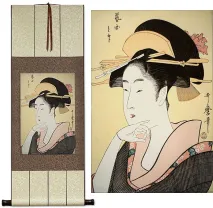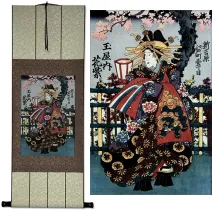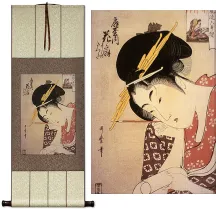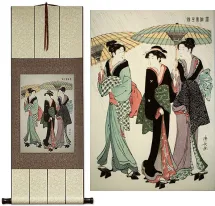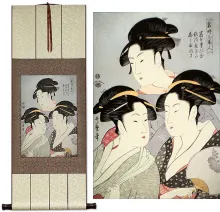Departing Spring
Japanese Woman Woodblock Print Repro
Wall Scroll
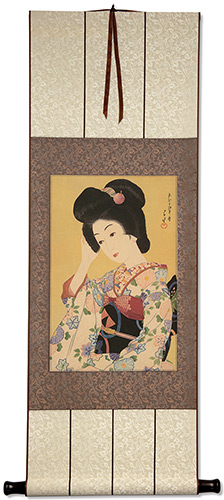

41½"
18¼"
• Delivered to you in Columbus by Apr 27th.
• Standard shipping is just $3.80 for any order.
• Limited Edition Print - I might make more.
• Fine Art Giclée Print.
• Handmade Wall Scroll.
• Money-Back Guarantee.

This Asian woman artwork will look great in your home or office.
Approximate Measurements
Artwork Panel: 28.3cm x 43.3cm ≈ 11" x 17"
Silk/Brocade: 37.3cm x 105.7cm ≈ 14¾" x 41½"
Width at Wooden Knobs: 46.3cm ≈ 18¼"
Information about caring for your wall scrollSee Larger Image



Departing Spring
Yuku Haru
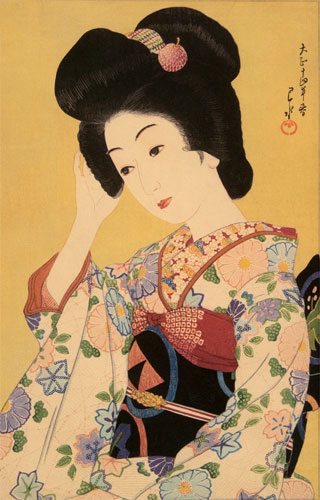
Close up view of the Asian woman artwork mounted to this silk brocade wall scroll
This is artist Hasui’s only bijgin-ga or beautiful woman portrait (he typically only did landscapes).
This artwork features a young woman adjusting her hair. Based on the artwork's title, perhaps she is about to enter the summer of her youth.
The round Watanabe seal was used until 1925 this fact helps narrow the date the original was created. The outlines of her face and hand are done with red instead of black or grey, which is highly unusual and perhaps experimental.
The title is 行く春 or "Yuku Haru" which means Departing Spring or The Fading of Spring.
Original artist: Kawase Hasui 川瀬 巴水, (1883–1957).
Publisher: Watanabe Shōzaburō.
Original woodblock was created in Japan, in 1925 (later versions were printed as late as 1931 with different seals).
More about the artist from https://www.roningallery.com/departing-spring-yuku-haru:
Regarded as a major Japanese landscape artist of the 20th century, Hasui Kawase’s prints are characterized by their serenity of mood and flawless composition. Born Bunjiro Kawase in Tokyo, Hasui Kawase was the son of a silk braid merchant. He began his artistic career studying Japanese-style painting with Kiyokata, as well as Western-style at the Hakubakai. His talent was clear, exhibiting in the Tatsumi Exhibition of Painting at age 19. However, soon after seeing Shinsui’s series Eight Views of Lake Biwa, Hasui turned his attention to woodblock printing in 1919. Shozaburo Watanabe was the first to recognize his artistic genius and Hasui Kawase soon became the most popular artist working for this prestigious publisher. Hasui traveled widely in Japan and his subjects consisted mostly of his surroundings. These Japanese landscape prints are based on small, quick sketches and watercolors taken from nature. Unfortunately, during the earthquake of 1923, all of his woodblocks and over 200 sketches were destroyed. The works that predate this event are extremely scarce and in great demand today. Undaunted, Hasui continued to produce his landscape prints. In 1956, the Japanese government’s Committee for the Preservation of Intangible Cultural Heritage designated Hasui's Zojo Temple in Snow and the documentation of its production as Intangible Cultural Treasures, the greatest artistic honor in postwar Japan. All of his prints are signed “Hasui” usually with a variety of red seals reading “sui.” Though Watanabe published the majority of Hasui Kawase’s prints, Doi, Kawaguchi, Sakai, and others published some designs as well.
About Real Japanese Woodblock Prints
Contrary to popular belief, woodblock printing (and in a way, the first printing press) was invented in China. Both artwork and whole books were produced in China using the woodblock print technique. Much of this artwork and printed books made their way to Japan. Emulating the methods and adding to the style, Japanese artists took woodblock printing to the next level.
In Japan, wood block prints are known as 

 or "Moku Hanga". Most were produced during the Edo period (1603–1867). To put that in perspective, this started about when the USA was just becoming a British colony. Some artists continued creating prints into the early 1900s.
or "Moku Hanga". Most were produced during the Edo period (1603–1867). To put that in perspective, this started about when the USA was just becoming a British colony. Some artists continued creating prints into the early 1900s.
At that time, Japanese artists would create "template paintings" with detailed images of "everyday life" scenes of Japan. Some of these "everyday life" or 

 (Ukiyo-e), which translates as "Floating World" images, depict battling Samurai, beheadings, and even prostitution. This leads you to believe that "everyday life", was rather exciting in ancient Japan. However, most Ukiyo-e prints were more tame scenes of everything from women washing clothes, to men writing poetry.
(Ukiyo-e), which translates as "Floating World" images, depict battling Samurai, beheadings, and even prostitution. This leads you to believe that "everyday life", was rather exciting in ancient Japan. However, most Ukiyo-e prints were more tame scenes of everything from women washing clothes, to men writing poetry.
After creating the template, the artist would then have another artisan carve large blanks of wood with those images. The carved wood blocks were then given to yet another artisan, known as an "inker". The inker would then carefully apply wet ink or colorful paint to the various carved surfaces. A sheet of handmade paper was then pressed over the inked woodblock to create the final print. The process was laborious, but not as tedious as hand-painting hundreds of copies from scratch.
About This Reproduction
If this was an "original" Japanese woodblock print, dating back to the Edo period, the price would be anywhere from $800 to $20,000.
Just to be clear again: This is a reproduction.
The quality of this reproduction is very good, but a true expert will spot this as a reproduction after examining it.
I use handmade kozo (mulberry) paper - the same kind of paper that Japanese woodblock print makers used centuries ago.
The pigment-based inks are archival and UV-resistant. In independent laboratory testing the giclée prints created with this ink should survive 95 years with no signs of fading, if not in direct sunlight (this will outlast hand-painted artwork under the same conditions). I figure you'll get a lifetime of enjoyment if you take good care of this wall scroll.
I spend hours making sure the colors are vibrant, and touching up areas that might be damaged or missing from the old original print.
The result is very close to what the woodblock print would look like if you could go back in time to the Edo period, and buy it from the artist's studio in old Japan.

A photographer that I admire, Jeremy Cowart, and his Canon imagePROGRAF printer.
For years I tried to find a printer that could handle handmade paper without wrinkling, jamming, or clogging print heads.
I bought and tried several giclée printers valued at up to $15,000 each (when new). They gave mixed results, I finally found the quality I was looking for in a brand-new Canon imagePROGRAF PRO-2000. This printer has 18,432 nozzles and 12 ink tanks. That's 12 ink tanks costing up to $317 each. With the price of the printer at $2,853 it was a total investment of more than $6,000 - which is not a price tag for the faint of heart.
I have to use this printer in the USA to create the print, as I can't get a license for such a machine at my other studio in Beijing (The Chinese government fears that I will make counterfeit Chinese currency, or Pro-Democracy propaganda posters with it).
After carefully printing and inspecting this artwork, I sent the raw print on kozo paper to my workshop in Beijing where it was built into a handmade wall scroll.
This makes it ready-to-hang (no expensive framing needed), and gives the whole piece a very traditional Asian look.
Because the artist of this piece passed away long ago, and the original artwork is over 100 years old, there is no copyright. However, in some cases, I have paid a license fee to the owner of the original Japanese woodblock print for access to create the digitized image. In a few cases, I bought original 200-year-old woodblock prints and drum-scanned it at high-resolution.
All of this effort on my part means you get a really beautiful Japanese woodblock print reproduction, for a very affordable price. I am not sure I will ever make a profit on these (I would need to charge about double this price if that was the goal), but I really like to make unique Asian artwork affordable and accessible to everyone.
Want a customized wall scroll or custom-sized print? Just contact me!
I can print this larger, on the paper texture of your choice, and give you whatever silk brocade colors you want. Ready-to-frame prints can be delivered in a few days. However, it does take several weeks for custom wall scrolls. Either way, it's worth the wait if you want something really custom and unique.
This item was listed or modified
Aug 24th, 2023
